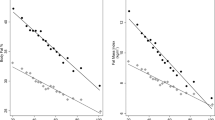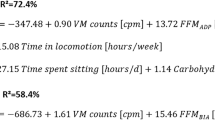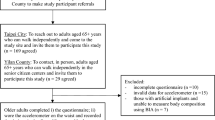Abstract
Objective:
To examine the within- and between-individual variability in the estimated total energy expenditure (TEE) and habitual physical activity (PA) in free-living young adults. We were specifically interested in the day-to-day variation.
Design:
Cross-sectional.
Setting:
University.
Subjects:
A total of 277 (125 males, 152 females) participants aged 18–24 years.
Interventions:
None.
Main outcome measures:
Subjects recorded their daily PA with the Bouchard 3-day diary. Descriptive statistics for TEE, moderate-to-vigorous physical activity (MVPA), inactivity (IA), and activity energy expenditure (AEE) were calculated and presented as a frequency distribution. Within- and between-individual variability were tested by RMANOVA and also presented as the coefficient of variation (CV).
Results:
Mean values for TEE, MVPA, AEE, and IA were comparable between males and females; however, considerable between-individual variability existed. Only MVPA showed a significant difference between sexes (P<0.05), due to slightly greater vigorous PA in males compared to females (8.0 and 6.8 kcal/kg/day, respectively; P=0.12). Results from the RMANOVA revealed no significant day-to-day variability in any TEE or PA variable and the CVs were not significantly different between males and females. TEE and IA displayed mean CVs of approximately 12% while mean CVs for AEE and MVPA approximated 32 and 84%, respectively.
Conclusions:
Results from this study suggest (1) a limited day-to-day variability in TEE and (2) a large degree of between-individual variation for TEE and PA exist. This study highlights the importance of understanding the variability associated with TEE, which is important for PA measurement and proper PA and nutritional recommendations.
Sponsorship:
None.
This is a preview of subscription content, access via your institution
Access options
Subscribe to this journal
Receive 12 print issues and online access
$259.00 per year
only $21.58 per issue
Buy this article
- Purchase on Springer Link
- Instant access to full article PDF
Prices may be subject to local taxes which are calculated during checkout



Similar content being viewed by others
References
Bennett A (1987). Interindividual variability: an underutilized resource. In: Feder M, Bennett A, Burggren W, Huey R (eds). New Directions in Ecological Physiology. Cambridge University Press: Cambridge, pp. 147–166.
Black AE, Cole TJ (2000). Within- and between-subject variation in energy expenditure measured by the doubly-labelled water technique: implications for validating reported dietary energy intake. Eur J Clin Nutr 54, 386–394.
Bouchard C, Rankinen T (2001). Individual differences in response to regular physical activity. Med Sci Sports Exerc 33, S446–S451.
Bouchard C, Tremblay A, Leblanc C, Lortie G, Savard R, Theriault G (1983). A method to assess energy expenditure in children and adults. Am J Clin Nutr 37, 461–467.
Bratteby L-E, Sandhagen Bo, Fan Hu, Samuelson G (1997). A 7-day activity diary for assessment of daily energy expenditure validated by the doubly labeled water method in adolescents. Eur J Clin Nutr 51, 585–591.
Brooks GA, Butte NF, Rand WM, Flatt JP, Caballero B (2004). Chronicle of the Institute of Medicine physical activity recommendation: how a physical activity recommendation came to be among dietary recommendations. Am J Clin Nutr 79, 921S–930S.
Buchowski MS, Acra S, Majchrzak KM, Sun M, Chen KY (2004). Patterns of physical activity in free-living adults in the Southern United States. Eur J Clin Nutr 58, 828–837.
Caspersen CJ, Pereira MA, Curran KM (2000). Changes in physical activity patterns in the United States, by sex and cross-sectional age. Med Sci Sports Exerc 32, 1601–1609.
Eaton SB, Eaton SB (2003). An evolutionary perspective on human physical activity: implications for health. Comp Biochem Physiol 136, 153–159.
FAO/WHO/UNU (1985). Energy and protein requirements. Report of a joint FAO/WHO/UNU Expert Consultation. World Health Organ Tech Rep Ser 724, 1–206.
Flegal KM, Carroll MD, Kuczmarski RJ, Johnson CL (1998). Overweight and obesity in the United States: prevalence and trends 1960–1994. Int J Obes 22, 39–47.
Garcia K, Eisenmann JC, Bartee RT (2004). Does a family history of coronary heart disease modify the relationship between physical activity and blood pressure in young adults? Eur J Cardiovasc Prev Rehabil 11, 201–206.
Goran MI, Beer WH, Wolfe RR, Poehlman ET, Young VR (1993). Variation in total energy expenditure in young healthy free-living men. Metabolism 42, 487–496.
Goran MI, Poehlman ET (1992). Endurance training does not enhance total energy expenditure in healthy elderly persons. Amer J Physiol 263, E950–E957.
Institute of Medicine of the National Academies of Science (IOM) (2002). Dietary Reference Intakes for Energy, Carbohydrate, Fiber, Fat, Fatty Acids, Cholesterol, Protein, and Amino Acids (Macronutrients). National Academy Press: Washington, DC.
Kaprio J, Koskenvuo M, Sarna S (1981). Cigarette smoking, use of alcohol, and leisure-time physical activity among same-sexed adult male twins. Prog Clin Biol Res 69, 37–46.
Keys A (1948). Cardiovascular effects of malnutrition and starvation. Mod Concepts Cardiovasc Dis 27, 21–38.
Kimm SY, Glynn NW, Kriska AM, Barton BA, Kronsberg SS, Daniels SR et al. (2002). Decline in physical activity in black girls and white girls during adolescence. N Engl J Med 347, 709–715.
Levine JA, Eberhardt NL, Jensen MD (1999). Role of nonexercise activity thermogenesis in resistance to fat gain in humans. Science 283, 212–214.
Levine JA, Lanningham-Foster LM, McCrady SK, Krizan AC, Olson LR, Kane PH et al. (2005). Interindividual variation in posture allocation: possible role in human obesity. Science 307, 584–586.
Loos RJ, Rankinen T, Tremblay A, Perusse L, Chagnon Y, Bouchard C (2005). Melanocortin-4 receptor gene and physical activity in the Quebec Family Study. Int J Obes Relat Metab Disord 29, 420–428.
Maia JAR, Thomis M, Beunen G (2002). Genetic factors in physical activity levels. Am J Prev Med 23, 87–91.
Ogden CL, Flegal KM, Carroll MD, Johnson CL (2002). Prevalence and trends in overweight among US children and adolescents, 1999–2000. JAMA 288, 1728–1732.
Pate RR, Pratt M, Blair SN, Haskell WL, Macera CA, Bouchard C et al. (1995). Physical activity and public health: a recommendation from the Centers for Disease Control and Prevention and the American College of Sports Medicine. JAMA 273, 402–407.
Perusse L, Tremblay A, Leblanc C, Bouchard C (1989). Genetic and environmental influences on level of habitual physical activity and exercise participation. Am J Epidemiol 129, 1012–1022.
Rowland TW (1998). The biological basis of physical activity. Med Sci Sports Exerc 30, 392–399.
Sallis JF, Hovell MF (1990). Determinants of exercise behavior. Exerc Sport Sci Rev 18, 307–330.
Schoeller DA (2001). The importance of clinical research: the role of thermogenesis in human obesity. Am J Clin Nutr 73, 511–516.
Scrimshaw NS, Waterlow JC, Schürch B (1996). Energy and Protein requirements. Proceedings of an IDECG workshop. Eur J Clin Nutr 50, S1–S197.
Simonen RL, Rankinen T, Perusse L, Leon AS, Skinner JS, Wilmore JH et al. (2003b). A dopamine D2 receptor gene polymorphism and physical activity in two family studies. Physiol Behav 78, 751–757.
Simonen RL, Rankinen T, Perusse L, Rice T, Rao DC, Chagnon Y et al. (2003a). Genome-wide linkage scan for physical activity levels in the Quebec family study. Med Sci Sports Exerc 35, 1355–1359.
Thorburn AW, Proietto J (2000). Biological determinants of spontaneous physical activity. Obes Rev 1, 87–94.
van Mechelen W, Twisk JWR, Post GB, Snel J, Kemper HCG (2000). Physical activity of young people: the Amsterdam Longitudinal Growth and Health Study. Med Sci Sports Exerc 32, 1610–1616.
Westerterp KR (1998). Alterations in energy balance with exercise. Am J Clin Nutr 68, 970S–974S.
Westerterp KR (2001). Pattern and intensity of physical activity. Nature 410, 539.
Westerterp KR, Meijer GA, Janssen EM, Saris WH, Ten Hoor F (1992). Long-term effect of physical activity on energy balance and body composition. Br J Nutr 68, 21–30.
Wolf AM, Colditz GA (1998). Current estimates of the economic cost of obesity in the United States. Obes Res 6, 97–106.
World Health Organization (WHO) (2002). Controlling the global obesity epidemic. Available at:http://www.who.int/nut/obs.htm.
Acknowledgements
The authors wish to thank Kristen Garcia, Julie Ryan, and the undergraduate research students who coded activity diaries and entered data as well as Dr Panteleimon Ekkekakis for insightful discussions regarding the biological basis of PA related to brain and behavior.
Author information
Authors and Affiliations
Corresponding author
Rights and permissions
About this article
Cite this article
Wickel, E., Eisenmann, J. Within- and between-individual variability in estimated energy expenditure and habitual physical activity among young adults. Eur J Clin Nutr 60, 538–544 (2006). https://doi.org/10.1038/sj.ejcn.1602348
Received:
Revised:
Accepted:
Published:
Issue Date:
DOI: https://doi.org/10.1038/sj.ejcn.1602348
Keywords
This article is cited by
-
No one accelerometer-based physical activity data collection protocol can fit all research questions
BMC Medical Research Methodology (2020)
-
Day-to-day variability in voluntary wheel running among genetically differentiated lines of mice that vary in activity level
European Journal of Applied Physiology (2009)



